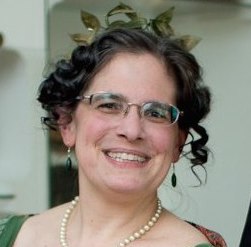Working my way through the waltz variations in Round Dancing (M. B. Gilbert, Portland, Maine, 1890) and La Danse (G. W. Lopp, Paris, 1903), here’s one that can fairly confidently be classified as a step rather than a sequence written for a particular piece of music. It’s actually quite interesting, though less for the step than for the fact that though at first glance it looks like a two-part sequence, it’s actually not. Gilbert specifically (and ungrammatically) wrote:
Repeat ad lib, commencing at the second part. At the termination of the side movement. Waltz at pleasure, introducing the second part at will.
In other words, waltz (the first part) for as long as you like, then do the second part (a set of sideways movements akin to a racket) for as long as you like. In short, use the second part as a variation in your waltzing. That’s in line with how I suspect many of these variations were actually used, but it’s unusual to see it stated so explicitly.
Gilbert and Lopp attributed the College Step to Russ B. Walker, a rather interesting dancing master whom I should discuss at length at some point. Gilbert further noted that it was “accepted by the American Society of Professors of Dancing, New York, April 10, 1881.”
There’s nothing new to reconstruct for the first part; it’s just waltzing, using the leaping “new” waltz of the late nineteenth century (leap back, step side, cut; leap forward, step side, cut) if one follows Gilbert’s standard. One could also dance it more sedately with the “glide” version of this waltz that keeps all the steps low and smooth (step, side, close rather than leap, slide, cut). Walker was associated with the glide version — possibly as its inventor — so there’s a certain logic to that, but I feel that it doesn’t go as well with the bouncy second part.
To begin that second part, the dancers should end their waltz with the gentleman’s back to the center of the room, ready to move sideways along the line of dance, gentleman’s left foot and lady’s right foot ready. Here’s the reconstruction giving the gentleman’s steps; the lady dances opposite as usual:
1 Leap sideways along line of dance onto left foot
2 Close right to left, raising left in third position
3 Replace left foot, extending right to raised second position
4 Cut right foot to left, extending left to raised second position
5 Put left foot down in second
6 Close right to left, raising left in third position
These two measures are repeated as many times as one likes before returning to ordinary waltzing. To make that change, start turning on the second measure, making a quarter-turn to put the gentleman in front of the lady, back to line of dance, ready to start the waltz again. One could also conceivably guide the lady in front of the gentleman to start a reverse waltz, but starting the waltz by pushing the lady into a backward leap is more awkward and less polite than pulling her into a forward leap.
It would also be possible to make a half-turn of waltz and do this step leading with the right foot; since Gilbert used the term ad lib three different times in the description, I feel that it’s easily within the spirit of things.
A reconstruction note: Gilbert did not actually specify that on the second and sixth beats the foot is raised in third position, just that it was raised. Since he did specify the raised second position on the third and fourth beats, I think the implication is that the other two are not to second, but rather keeping the raised foot close to the other leg. Lopp specified third position on the second beat, but said nothing about the sixth. I feel reasonably confident in specifying raised third for both.
This is not, incidentally, a variation that can be led spontaneously if one’s partner does not already know the step-sequence. It’s a bit tricky even if she does.
Differences in Lopp
1. Lopp offered a tempo of 184, which is fine for the waltz part but extremely fast for the other part.
2. As in La Eugénie, Lopp replaced “waltz” with “Boston” for the waltz segment (see my previous post for more on this), and which one chooses to use depends on what place and time one is attempting to reenact: original American style or later French style.
3. As noted above, Lopp specified the raised third position on the second beat.
4. Lopp also ended his description slightly differently. He, like Gilbert, noted that the second part can be repeated “at will”, meaning as many times as one likes, but then recommended that the dancers take care to always finish with the Boston.


Leave a Reply